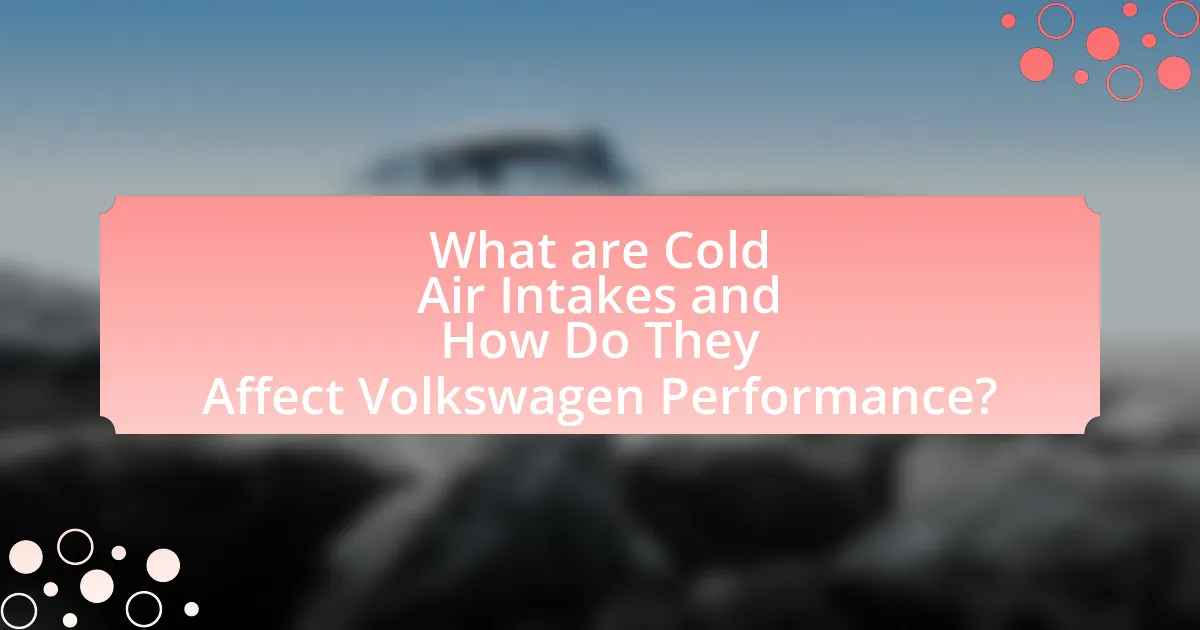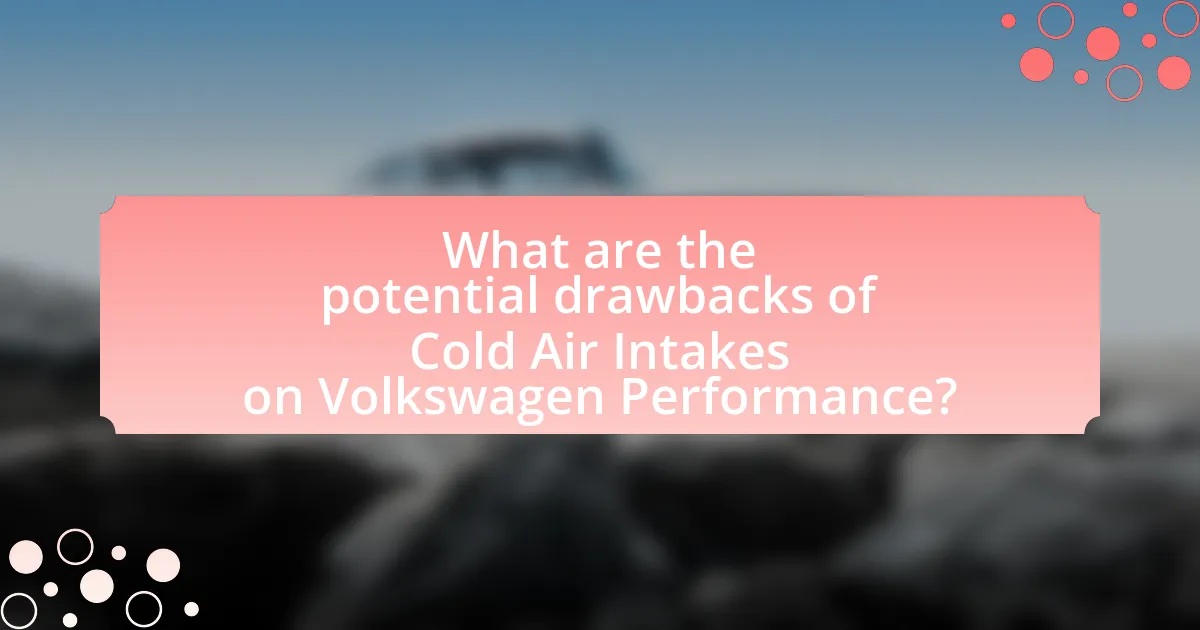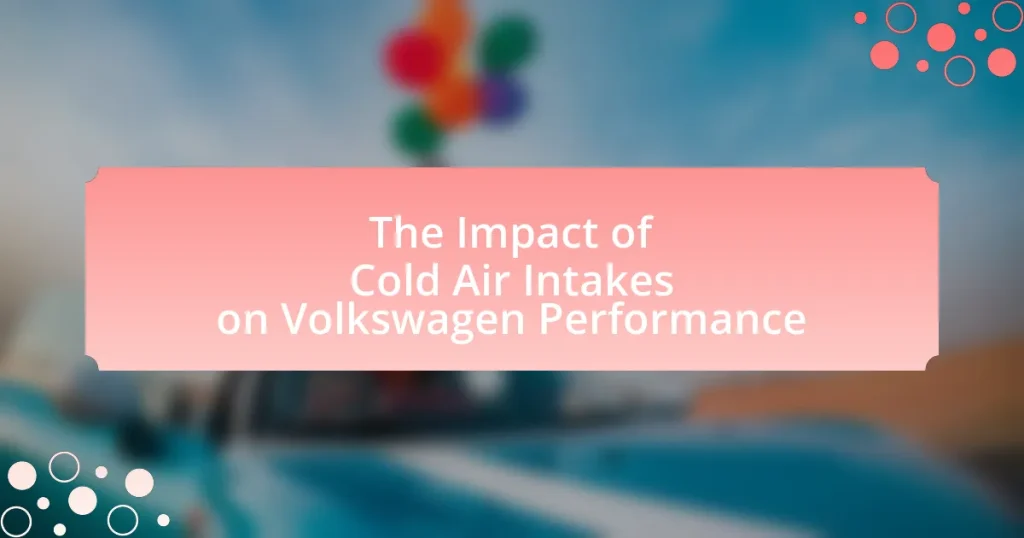Cold air intakes are aftermarket components that enhance engine performance in Volkswagen vehicles by allowing cooler, denser air to enter the engine, resulting in improved combustion efficiency and increased horsepower and torque. This article examines how cold air intakes function, their components, and the benefits they provide, including potential gains in fuel efficiency. It also discusses the different types of cold air intakes available, installation considerations, and the risks associated with their use, such as increased engine noise and potential warranty implications. Additionally, the article highlights best practices for maximizing the performance of cold air intakes, including the importance of tuning and complementary modifications.

What are Cold Air Intakes and How Do They Affect Volkswagen Performance?
Cold air intakes are aftermarket components designed to improve engine performance by allowing cooler, denser air to enter the engine. This increased airflow enhances combustion efficiency, leading to improved horsepower and torque in Volkswagen vehicles. Studies have shown that cold air intakes can increase engine power output by approximately 5-20%, depending on the specific model and tuning. Additionally, cooler air can improve fuel efficiency, as the engine can operate more effectively with the increased oxygen supply.
How do Cold Air Intakes function in Volkswagen vehicles?
Cold air intakes in Volkswagen vehicles function by replacing the factory air intake system with a design that draws in cooler, denser air from outside the engine compartment. This process enhances engine performance by increasing airflow, which can lead to improved combustion efficiency and power output. The cooler air is less prone to heat soak, allowing the engine to operate more effectively, especially under high-performance conditions. Studies have shown that vehicles equipped with cold air intakes can experience gains in horsepower and torque, demonstrating their effectiveness in optimizing engine performance.
What components make up a Cold Air Intake system?
A Cold Air Intake system consists of several key components: an intake tube, air filter, heat shield, and sometimes a mass airflow sensor adapter. The intake tube directs cooler air from outside the engine bay into the engine, enhancing airflow efficiency. The air filter is designed to capture contaminants while allowing maximum airflow, which is crucial for engine performance. The heat shield protects the intake from engine heat, ensuring that the air remains cool as it enters the engine. Additionally, some systems include a mass airflow sensor adapter to ensure proper air measurement for optimal fuel delivery. These components work together to improve engine performance by increasing airflow and reducing intake temperatures.
How does air temperature influence engine performance?
Air temperature significantly influences engine performance by affecting air density and oxygen availability. Cooler air is denser, allowing for a greater mass of oxygen to enter the engine, which enhances combustion efficiency and power output. For instance, studies show that a decrease in air temperature by 10 degrees Fahrenheit can increase horsepower by approximately 1-2%. Conversely, warmer air reduces density, leading to less oxygen intake and diminished engine performance. This relationship is crucial for optimizing engine tuning and performance enhancements, particularly in vehicles equipped with cold air intakes, which are designed to draw in cooler air to maximize efficiency and power.
What are the potential benefits of installing a Cold Air Intake on a Volkswagen?
Installing a Cold Air Intake on a Volkswagen can enhance engine performance by increasing horsepower and torque. This improvement occurs because a Cold Air Intake allows the engine to draw in cooler, denser air, which can lead to more efficient combustion. Studies indicate that vehicles equipped with Cold Air Intakes can experience a horsepower increase of approximately 5 to 20 percent, depending on the specific model and engine configuration. Additionally, the improved airflow can lead to better throttle response and fuel efficiency, making it a popular modification among Volkswagen enthusiasts.
How does a Cold Air Intake improve horsepower and torque?
A Cold Air Intake improves horsepower and torque by allowing the engine to draw in cooler, denser air, which enhances combustion efficiency. This increased airflow leads to a more complete fuel burn, resulting in higher power output. Studies have shown that vehicles equipped with cold air intakes can experience horsepower gains of 5 to 20 horsepower, depending on the engine type and design. Additionally, the improved air density contributes to better torque delivery across the RPM range, making the vehicle more responsive.
What impact does a Cold Air Intake have on fuel efficiency?
A Cold Air Intake can improve fuel efficiency by allowing the engine to draw in cooler, denser air, which enhances combustion. This increased airflow can lead to better fuel atomization and more efficient combustion, resulting in improved miles per gallon (MPG). Studies have shown that vehicles equipped with a Cold Air Intake can experience fuel efficiency gains of approximately 5-10%, depending on the specific vehicle and driving conditions. This improvement is attributed to the enhanced air-to-fuel ratio, which optimizes engine performance and reduces the amount of fuel needed for the same power output.

What are the different types of Cold Air Intakes available for Volkswagens?
The different types of cold air intakes available for Volkswagens include short ram intakes, cold air intakes, and performance air filters. Short ram intakes are designed to replace the factory air intake system with a shorter, less restrictive path for air, enhancing throttle response. Cold air intakes draw air from outside the engine bay, providing cooler air for improved combustion efficiency. Performance air filters, often used in conjunction with other intake systems, increase airflow while filtering out contaminants. These types of cold air intakes contribute to enhanced engine performance by improving airflow and reducing intake temperatures, which can lead to increased horsepower and torque.
How do short ram and cold air intakes differ in performance?
Short ram intakes and cold air intakes differ primarily in their air temperature management and resulting performance impact. Short ram intakes draw air from the engine bay, which is typically warmer, leading to reduced air density and potentially lower performance gains. In contrast, cold air intakes are designed to pull in cooler air from outside the engine compartment, enhancing air density and combustion efficiency, which can result in improved horsepower and torque. Studies have shown that cold air intakes can increase engine performance by 5-20%, depending on the vehicle and conditions, while short ram intakes may yield less significant gains due to the warmer air intake.
What are the advantages of using a short ram intake?
A short ram intake offers improved airflow to the engine, resulting in enhanced throttle response and increased horsepower. This design reduces the distance air travels before entering the engine, minimizing turbulence and allowing for a more direct path. Additionally, short ram intakes often feature larger diameter piping, which can further facilitate airflow. Studies have shown that vehicles equipped with short ram intakes can experience a horsepower increase of approximately 5-10%, depending on the specific vehicle and conditions. This performance enhancement is particularly beneficial for Volkswagen models, where optimizing air intake can significantly impact overall engine efficiency and responsiveness.
What benefits does a cold air intake provide over a short ram intake?
A cold air intake provides superior performance benefits over a short ram intake by delivering cooler, denser air to the engine, which enhances combustion efficiency. This cooler air, typically sourced from outside the engine bay, results in increased horsepower and torque, as cooler air has a higher oxygen content compared to the warmer air drawn in by a short ram intake. Studies have shown that cold air intakes can improve engine performance by 5-20% depending on the vehicle and conditions, making them a more effective choice for optimizing Volkswagen performance.
What factors should be considered when choosing a Cold Air Intake for a Volkswagen?
When choosing a Cold Air Intake for a Volkswagen, factors such as compatibility, material quality, design type, and performance gains should be considered. Compatibility ensures that the intake fits the specific Volkswagen model and engine type, preventing installation issues. Material quality affects durability and heat resistance; for instance, aluminum and high-density polyethylene are commonly used for their lightweight and heat-dissipating properties. The design type, whether short ram or cold air, influences airflow and temperature, with cold air intakes generally providing better performance by drawing cooler air from outside the engine bay. Performance gains can be quantified through horsepower and torque improvements, which are often documented in product specifications and independent testing, confirming the effectiveness of the chosen intake.
How does the brand and model of the intake affect performance?
The brand and model of the intake significantly influence performance by determining airflow efficiency and filtration quality. High-quality brands often utilize advanced materials and designs that enhance airflow, resulting in improved engine responsiveness and power output. For instance, a study by the Society of Automotive Engineers found that specific cold air intakes can increase horsepower by up to 10-15% compared to stock intakes, demonstrating the tangible benefits of selecting a reputable brand and model. Additionally, models designed for specific vehicle types, like those tailored for Volkswagen, ensure optimal fitment and performance, further validating the importance of brand and model selection in achieving desired performance outcomes.
What installation considerations should be taken into account?
When installing cold air intakes on Volkswagen vehicles, several considerations must be taken into account to ensure optimal performance and compatibility. First, the specific model and year of the Volkswagen must be identified, as different models may have unique engine configurations and space constraints that affect installation. Additionally, the quality of the cold air intake system is crucial; selecting a reputable brand can prevent issues such as improper fitment or inadequate filtration, which can harm engine performance.
Furthermore, the installation location should be assessed to ensure that the intake draws in cooler air, as this significantly impacts performance gains. Proper sealing and connection to the engine are also essential to avoid air leaks that can reduce efficiency. Lastly, local regulations regarding emissions and modifications should be reviewed, as some cold air intakes may not comply with legal standards, potentially leading to fines or vehicle inspections.

What are the potential drawbacks of Cold Air Intakes on Volkswagen Performance?
Cold air intakes can negatively impact Volkswagen performance by potentially causing issues such as increased engine noise, reduced low-end torque, and the risk of hydrolock. Increased engine noise occurs because cold air intakes often lack sound insulation, leading to a louder intake sound that some drivers may find undesirable. Reduced low-end torque is a common drawback, as these systems may optimize airflow for higher RPMs at the expense of performance in lower RPM ranges, which can affect drivability in everyday conditions. Additionally, the risk of hydrolock arises when water enters the engine through the intake, particularly in wet conditions, which can cause severe engine damage. These drawbacks highlight the importance of considering both the benefits and potential risks associated with cold air intakes for Volkswagen vehicles.
What risks are associated with installing a Cold Air Intake?
Installing a Cold Air Intake (CAI) can lead to several risks, including potential engine damage, voiding of warranties, and issues with air-fuel mixture. The introduction of a CAI may allow excessive amounts of unfiltered air and contaminants into the engine, which can cause premature wear or damage to engine components. Additionally, many manufacturers state that modifications like CAIs can void vehicle warranties, leaving owners responsible for repairs. Furthermore, a CAI can alter the air-fuel mixture, potentially leading to engine performance issues or even failure if not properly tuned. These risks highlight the importance of careful consideration and proper installation when opting for a Cold Air Intake.
How can a Cold Air Intake affect engine longevity?
A cold air intake can enhance engine longevity by improving airflow and reducing engine temperatures. Increased airflow allows for better combustion efficiency, which can lead to a more complete burn of fuel and reduced carbon buildup in the engine. Additionally, cooler air entering the engine can lower the operating temperature, minimizing thermal stress on engine components. Studies have shown that engines operating at lower temperatures tend to experience less wear and tear, thereby extending their lifespan. For instance, a study published in the Journal of Automotive Engineering indicated that optimized air intake systems can lead to a 5-10% increase in engine efficiency, contributing to overall durability.
What are the implications for warranty coverage with Cold Air Intakes?
Installing a cold air intake can potentially void or alter the warranty coverage of a vehicle. Manufacturers often include clauses in their warranty agreements that state modifications, such as the installation of aftermarket parts like cold air intakes, may lead to denial of warranty claims if the modification is deemed to have caused the issue. For example, the Magnuson-Moss Warranty Act allows manufacturers to deny warranty coverage if they can prove that the aftermarket part caused the damage. Therefore, vehicle owners should carefully review their warranty terms and consult with their dealership before making such modifications to understand the specific implications for their warranty coverage.
How can users mitigate the downsides of Cold Air Intakes?
Users can mitigate the downsides of Cold Air Intakes by ensuring proper installation and maintenance. Proper installation minimizes the risk of engine damage and ensures optimal airflow, which is crucial for performance. Regular maintenance, such as cleaning or replacing filters, prevents dirt accumulation that can hinder performance and lead to engine issues. Additionally, users should monitor engine performance and temperature to identify any adverse effects early. Research indicates that poorly maintained Cold Air Intakes can lead to a decrease in engine efficiency, highlighting the importance of these practices for maintaining Volkswagen performance.
What maintenance practices should be followed for Cold Air Intakes?
Regular maintenance practices for cold air intakes include cleaning or replacing the air filter, inspecting the intake system for leaks or damage, and ensuring proper installation. Cleaning the air filter, typically every 10,000 to 15,000 miles, helps maintain optimal airflow and engine performance. Inspecting the intake system for any cracks or loose connections prevents air leaks that can negatively affect engine efficiency. Proper installation checks ensure that the intake is securely fitted, which is crucial for maintaining performance and avoiding potential issues.
How can users ensure optimal performance from their Cold Air Intake?
Users can ensure optimal performance from their Cold Air Intake by regularly maintaining and cleaning the filter, as well as ensuring proper installation and fitment. Regular maintenance, such as cleaning or replacing the air filter, can enhance airflow and prevent restrictions that may hinder performance. Proper installation ensures that the intake system is sealed correctly, preventing unfiltered air from entering the engine, which can lead to damage. Additionally, users should monitor engine performance and make adjustments as necessary, as a well-tuned engine can maximize the benefits of a Cold Air Intake.
What are the best practices for maximizing the benefits of Cold Air Intakes on Volkswagens?
To maximize the benefits of Cold Air Intakes on Volkswagens, ensure proper installation and use high-quality components. Proper installation involves securely fitting the intake system to prevent air leaks, which can diminish performance. High-quality components, such as filters that allow for optimal airflow while providing adequate filtration, enhance engine efficiency. Additionally, regular maintenance, including cleaning or replacing filters as needed, ensures sustained performance improvements. Studies indicate that vehicles equipped with well-maintained cold air intakes can experience an increase in horsepower and torque, demonstrating the effectiveness of these practices in enhancing Volkswagen performance.
How can tuning complement the installation of a Cold Air Intake?
Tuning can significantly enhance the performance benefits gained from installing a Cold Air Intake by optimizing the engine’s air-fuel mixture and ignition timing. When a Cold Air Intake is installed, it increases the volume of cooler air entering the engine, which can improve combustion efficiency. However, without tuning, the engine’s control unit may not fully adjust to this increased airflow, potentially leading to suboptimal performance. Tuning recalibrates the engine management system to take advantage of the additional airflow, resulting in improved horsepower and torque. Studies have shown that vehicles with both a Cold Air Intake and proper tuning can experience performance gains of up to 10-20%, demonstrating the importance of tuning in maximizing the benefits of a Cold Air Intake.
What other modifications work well with Cold Air Intakes for enhanced performance?
Other modifications that work well with Cold Air Intakes for enhanced performance include performance exhaust systems, engine tuning, and upgraded fuel injectors. Performance exhaust systems improve airflow, reducing back pressure and allowing the engine to expel exhaust gases more efficiently, which complements the increased air intake from cold air intakes. Engine tuning, such as ECU remapping, optimizes fuel and air mixture for better combustion, maximizing the benefits of both the cold air intake and exhaust modifications. Upgraded fuel injectors provide a higher flow rate, ensuring that the engine receives adequate fuel to match the increased air intake, thus enhancing overall performance. These modifications collectively contribute to improved horsepower and torque, making them effective companions to cold air intakes.


